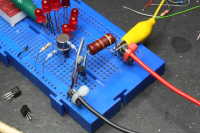



I use solderless breadboards for many of my circuits, at least in the early stages of the design. To connect the circuit to the power supply, I simply cut short lengths of solid-core wire and connect them with crocodile clip leads. The wire I use usually comes from a piece of telecoms cable which had many twisted pairs in one outer sheath, As for the crocodile clips, they present something of a hazard for short circuits, and they often pull the wires out of the breaboard. So, I was on the lookout for a better way to do it.
I had a number of old wire-wrap sockets which I'd saved from somewhere (probably someone who was throwing them out), and some of them were a bit broken. I took one of those sockets and cut off four pins. They were low-profile turned-pin wire-wrap sockets, which meant that it was easy to cut them into smaller sections as required. Two of the pins, I then trimmed back, leaving the other two pins at the full length (to plug into the breadboard). I soldered some wire to the pins and attached a cable tie for a bit of strain relief. On the other end, I fitted some 4mm plugs to suit my power supply. In all, I made up four cables, enough for circuits that need positive and negative supplies (op-amps) as well as a 5V logic supply.
The photo set showing the making of the leads was picked up by the Make magazine blog in May 2008.
Detailed photos of the breadboard connectors are available in this Flickr set.
Return to the Creative Technology page
Return to John Honniball's home page
Copyright © 2008 by John Honniball. All rights reserved.